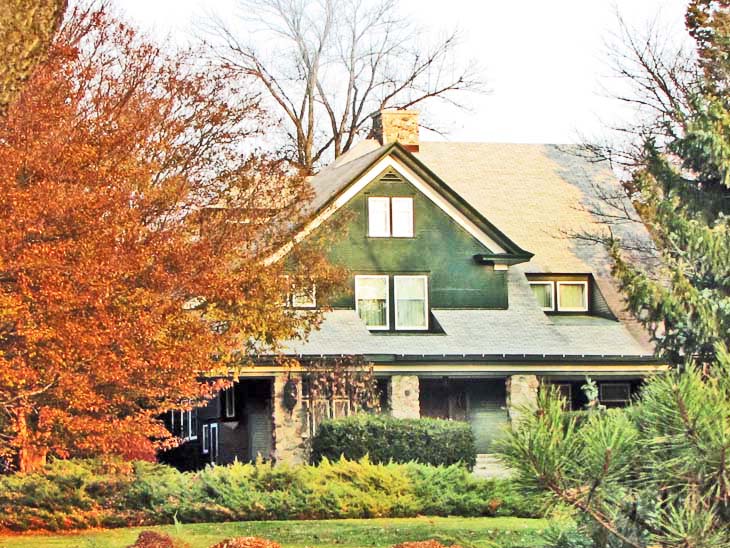

There are only a few National Historic Landmarks that commemorate the contributions of a research scientist. And there are not many scientists who have successfully used their scholarly research to develop a very large and successful business.
Herbert Dow was born in Belleville, Ontario in 1866. His father was a mechanical engineer who traveled around the eastern United States and Canada, installing new manufacturing machines and modernizing old ones in factories. When Herbert Dow was just six weeks old, his family moved to Connecticut, and later, on to Cleveland, where his father worked for a major shovel producer. As a young boy, Dow apparently accompanied his father to work and learned a great deal about mechanical processing in the nation’s industries.
Some disciplines, such as philosophy, mathematics and history, can be traced back to the Greek and Roman scholars. Other disciplines are much newer. Chemistry is one of the younger ones. Herbert Dow graduated from high school in Cleveland in 1884 and enrolled at the Case School of Applied Science, one of this nations’ early engineering schools and an institution whose faculty contributed substantially to development of modern chemistry. There is a fascinating history of how some traditional colleges in the United States disdained schools of applied engineering, but a few new universities specializing in science and engineering were founded in the late Nineteenth Century.
Oil wells had been drilled near Midland by the time Dow was studying chemistry at Case. When they were drilled, the oil men found that their wells often produced much brine which was not what they wanted. Oil wells near Canton, Ohio also produced brine. As a college assignment, Dow was ask to consult with the oil men from Canton and Midland and, presumably, encouraged to help them solve their problem of excess brine. Dow discovered that the brine contained bromine in an ionic form along with lithium. At that time, bromine was used to make medicines and in photographic chemicals, but it was a costly and laborious process to extract it. While an undergraduate in Cleveland, Dow invented a new method to more easily and efficiently extract bromine from the brine that Michigan and Ohio oil wells produced. By 1889, he had his first patent.
Just after graduating from Case, Herbert Dow moved to Canton, Ohio where he established a firm and sought to profit from his new strategy for obtaining bromine. However, his company failed. Ohio’s loss was Michigan’s gain since, in 1890, Herbert Dow moved to Midland where he once again sought to profitably produce bromine from the excess brine pumpted by local oil wells. He established the Midland Chemical Company and used electrolysis to oxidize brine from local wells. This was a creative period for Dow as he developed new processes for producing not only bromine but such chemicals as chlorine and sodium hydroxide. However, he did not have much success finding investors in Midland so he moved back to Cleveland where he successfully convinced faculty members at Case to invest in his business enterprise.
In 1896, Dow returned to Midland where he established the Dow Chemical Company that survives to this day. At some point, Dow realized that Midland was located above the bed of an ancient sea. He presumed that seabed contained many useful chemicals if they could be extracted and marketed. He insisted that his firm have a research orientation so many new processes were developed. When he died in 1930, Dow held 90 patents. However, he was also a shrewd business person who established his successful firm. In the early 1900s, German companies sought to monopolize the production of many of the most valuable chemicals. Dow challenged the German cartels and marketed his chemicals in Europe despite the very strong opposition of the German firms. Dow was also a philanthropist who supported numerous local endeavors.
Michigan scientists, entrepreneurs, designers and engineers deserve their accolades. By the late Nineteenth Century, Detroit was a center for the development of pharmaceuticals and was about to become axis mundi for the vehicle industry, thanks to Henry Ford, Henry Leland, R. E. Olds and dozens of others. And Midland was a national center for the development of the modern chemical industry, thanks to Herbert Dow.
When Herbert Dow had this attractive home built for his family, his firm was young and, presumably, quite fragile. That may explain why he did not engage one of the leading Detroit architects who were then designing impressive mansions for Detroit most prosperous families. There are few places in the United States where National Historic Landmarks are almost next to one another. In Detroit, Albert Kahn’s Fisher Building is just across the street from his General Motors Building. Herbert Dow’s son did not follow his grandfather into mechanical engineering or his father into chemical research. Rather, he studied architecture and became one of the most accomplished followers of Frank Lloyd Wright. The residence and studio that Alden Dow designed for himself is also a National Historic Landmark and is located no more than one-half mile from the distinguished but much more modest home of Herbert Dow pictured above.
Architect: Unknown to me
Date of construction: 1899
Architectural Style: Venacular
Use in 2012: Private Residence
State of Michigan Registry of Historic Sites: P68
State of Michigan Historical Marker: None erected
National Historic Landmark: Listed May 11, 1976
National Registry of Historic Places: Listed May 11, 1976
Photograph: Ren Farley; November 13, 2010
Description updated: February, 2012
Return to Michigan Historic Landmarks
Return to Michigan Registered Historic Districts
Return to Homepage